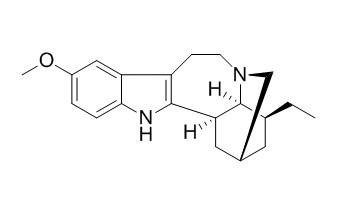Ibogaine
Ibogaine has promising anti-addictive property in animals. It has the propensity to prolong the QT interval of the electrocardiogram in humans, may generate life-threatening cardiac arrhythmias.
Inquire / Order:
manager@chemfaces.com
Technical Inquiries:
service@chemfaces.com
Tel:
+86-27-84237783
Fax:
+86-27-84254680
Address:
1 Building, No. 83, CheCheng Rd., Wuhan Economic and Technological Development Zone, Wuhan, Hubei 430056, PRC
Providing storage is as stated on the product vial and the vial is kept tightly sealed, the product can be stored for up to
24 months(2-8C).
Wherever possible, you should prepare and use solutions on the same day. However, if you need to make up stock solutions in advance, we recommend that you store the solution as aliquots in tightly sealed vials at -20C. Generally, these will be useable for up to two weeks. Before use, and prior to opening the vial we recommend that you allow your product to equilibrate to room temperature for at least 1 hour.
Need more advice on solubility, usage and handling? Please email to: service@chemfaces.com
The packaging of the product may have turned upside down during transportation, resulting in the natural compounds adhering to the neck or cap of the vial. take the vial out of its packaging and gently shake to let the compounds fall to the bottom of the vial. for liquid products, centrifuge at 200-500 RPM to gather the liquid at the bottom of the vial. try to avoid loss or contamination during handling.
Pharmaceutics.2020, 12(9):882.
Planta Med.2016, 82(13):1208-16
Clin Transl Med.2021, 11(5):e392.
JLiquid Chromatography & Related Tech.2021, 10826076.
The Korea Journal of Herbology2016, 29-35
Int J Mol Sci.2023, 24(3):2102.
Food Bioscience2024, 57:103518.
Int J Pharmacol2020, 16:1-9
Food Chem.2020, 313:126079
Sci Rep.2023, 13(1):13610.
Related and Featured Products
Toxicol Appl Pharmacol. 2013 Dec 1;273(2):259-68.
Anti-addiction drug ibogaine inhibits voltage-gated ionic currents: a study to assess the drug's cardiac ion channel profile.[Pubmed:
23707769]
The plant alkaloid Ibogaine has promising anti-addictive properties. Albeit not licensed as a therapeutic drug, and despite hints that Ibogaine may perturb the heart rhythm, this alkaloid is used to treat drug addicts. We have recently reported that Ibogaine inhibits human ERG (hERG) potassium channels at concentrations similar to the drugs affinity for several of its known brain targets. Thereby the drug may disturb the heart's electrophysiology.
METHODS AND RESULTS:
Here, to assess the drug's cardiac ion channel profile in more detail, we studied the effects of Ibogaine and its congener 18-Methoxycoronaridine (18-MC) on various cardiac voltage-gated ion channels. We confirmed that heterologously expressed hERG currents are reduced by Ibogaine in low micromolar concentrations. Moreover, at higher concentrations, the drug also reduced human Nav1.5 sodium and Cav1.2 calcium currents. Ion currents were as well reduced by 18-MC, yet with diminished potency. Unexpectedly, although blocking hERG channels, Ibogaine did not prolong the action potential (AP) in guinea pig cardiomyocytes at low micromolar concentrations. Higher concentrations (≥ 10 μM) even shortened the AP. These findings can be explained by the drug's calcium channel inhibition, which counteracts the AP-prolonging effect generated by hERG blockade. Implementation of Ibogaine's inhibitory effects on human ion channels in a computer model of a ventricular cardiomyocyte, on the other hand, suggested that Ibogaine does prolong the AP in the human heart.
CONCLUSIONS:
We conclude that therapeutic concentrations of Ibogaine have the propensity to prolong the QT interval of the electrocardiogram in humans. In some cases this may lead to cardiac arrhythmias.
Addict Biol. 2014 Mar;19(2):237-9.
Anti-addiction drug ibogaine inhibits hERG channels: a cardiac arrhythmia risk.[Pubmed:
22458604]
Ibogaine, an alkaloid derived from the African shrub Tabernanthe iboga, has shown promising anti-addictive properties in animals.
METHODS AND RESULTS:
Anecdotal evidence suggests that Ibogaine is also anti-addictive in humans. Thus, it alleviates drug craving and impedes relapse of drug use. Although not licensed as therapeutic drug, and despite evidence that Ibogaine may disturb the rhythm of the heart, this alkaloid is currently used as an anti-addiction drug in alternative medicine.
CONCLUSIONS:
Here, we report that therapeutic concentrations of Ibogaine reduce currents through human ether-a-go-go-related gene potassium channels. Thereby, we provide a mechanism by which Ibogaine may generate life-threatening cardiac arrhythmias.
Behav Brain Res. 2013 Jan 1;236(1):258-69.
Unique and potent effects of acute ibogaine on zebrafish: the developing utility of novel aquatic models for hallucinogenic drug research.[Pubmed:
22974549]
An indole alkaloid, Ibogaine is the principal psychoactive component of the iboga plant, used by indigenous peoples in West Africa for centuries. Modulating multiple neurotransmitter systems, the drug is a potent hallucinogen in humans, although its psychotropic effects remain poorly understood. Expanding the range of model species is an important strategy for translational neuroscience research.
METHODS AND RESULTS:
Here we exposed adult zebrafish (Danio rerio) to 10 and 20mg/L of Ibogaine, testing them in the novel tank, light-dark box, open field, mirror stimulation, social preference and shoaling tests. In the novel tank test, the zebrafish natural diving response (geotaxis) was reversed by Ibogaine, inducing initial top swimming followed by bottom dwelling. Ibogaine also attenuated the innate preference for dark environments (scototaxis) in the light-dark box test. While it did not exert overt locomotor or thigmotaxic responses in the open field test, the drug altered spatiotemporal exploration of novel environment, inducing clear preference of some areas over others. Ibogaine also promoted 'mirror' exploration in the mirror stimulation test, disrupted group cohesion in the shoaling test, and evoked strong coloration responses due to melanophore aggregation, but did not alter brain c-fos expression or whole-body cortisol levels.
CONCLUSIONS:
Overall, our results support the complex pharmacological profile of Ibogaine and its high sensitivity in zebrafish models, dose-dependently affecting multiple behavioral domains. While future investigations in zebrafish may help elucidate the mechanisms underlying these unique behavioral effects, our study strongly supports the developing utility of aquatic models in hallucinogenic drug research. High sensitivity of three-dimensional phenotyping approaches applied here to behavioral effects of Ibogaine in zebrafish provides further evidence of how 3D reconstructions of zebrafish swimming paths may be useful for high-throughput pharmacological screening.



